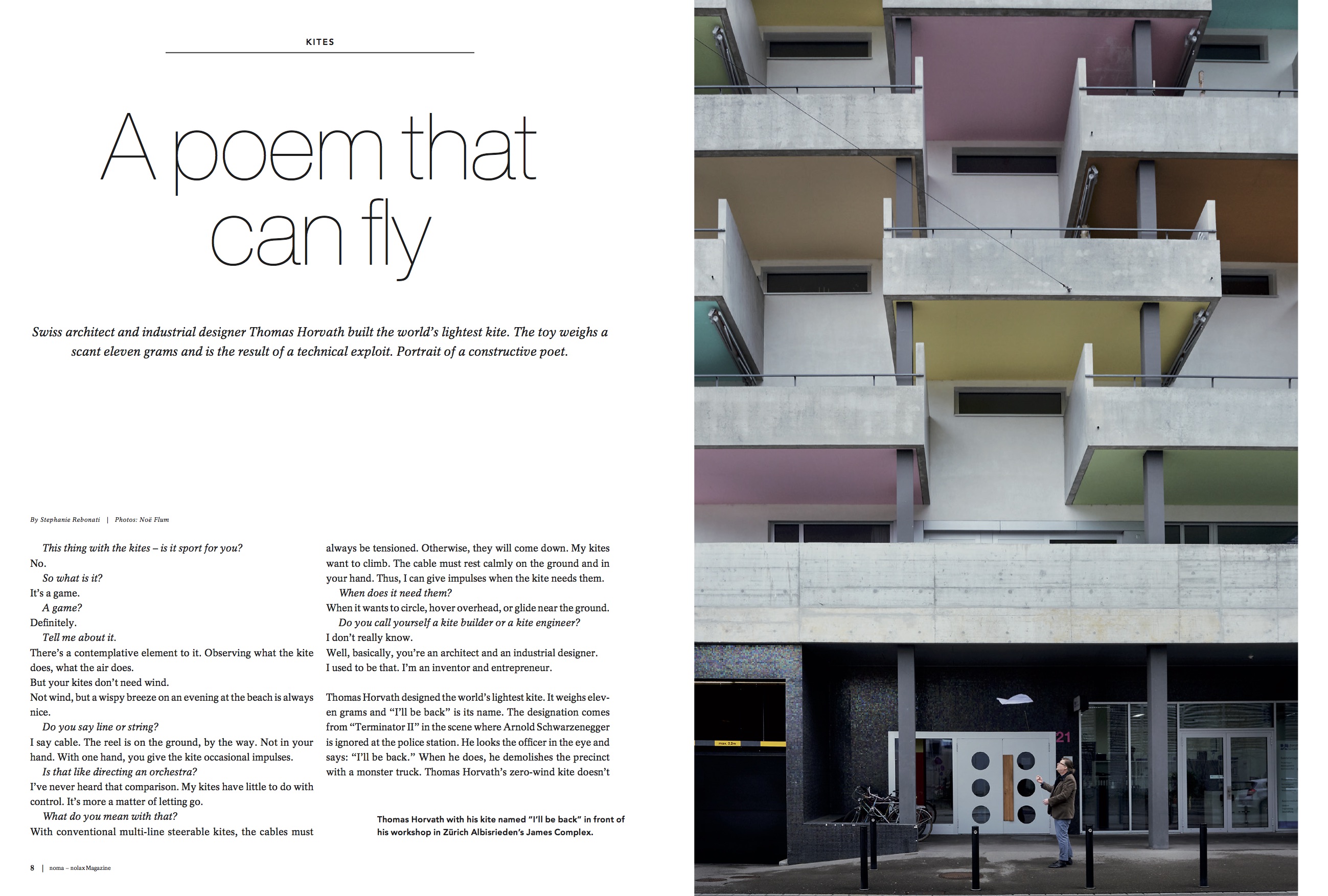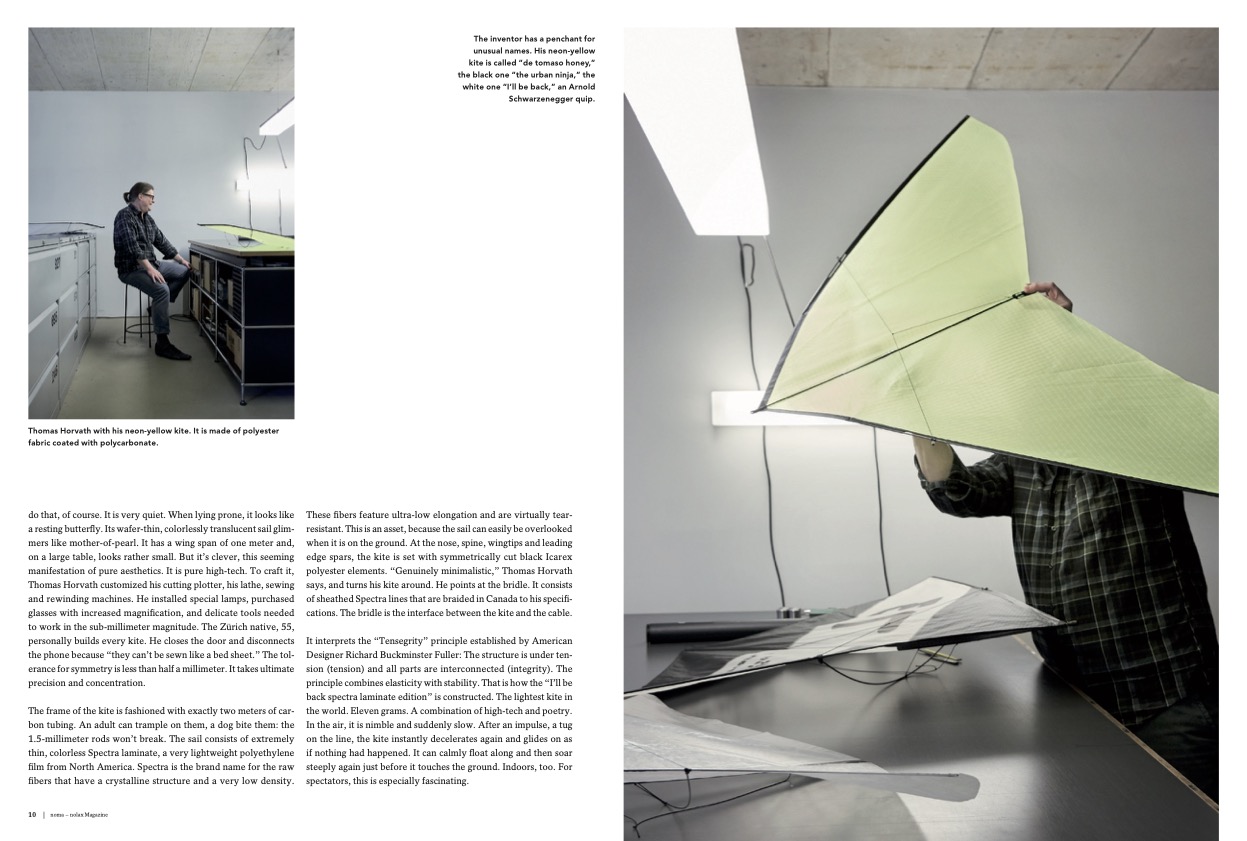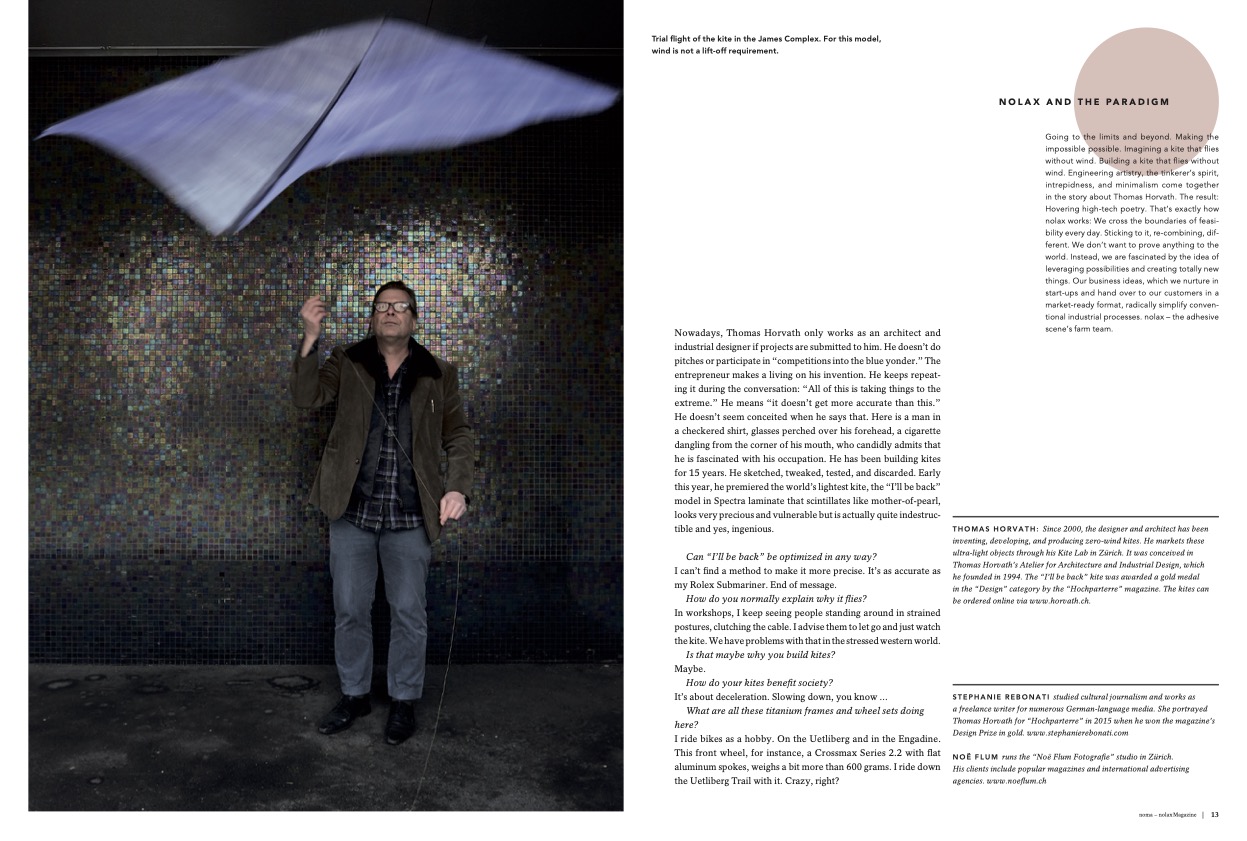08.04.2016, Noma Magazin
A Poem that can fly
Swiss architect and industrial designer Thomas Horvath built the world's lightest kite. The toy weighs a scant eleven grams and is the result of a technical exploit. Portrait of a constructive poet.
Text: Stephanie Rebonati
Photos: Noë Flum
This thing with the kites—is it sport for you?
No.
So what is it?
It’s a game.
A game?
Definitely.
Tell me about it.
There’s a contemplative element to it. Observing what the kite does, what the air does.
But your kites don’t need wind.
Not wind, but a wispy breeze on an evening at the beach is always nice.
Do you say line or string?
I say cable. The reel is on the ground, by the way. Not in your hand. With one hand, you give the kite occasional impulses.
Is that like directing an orchestra?
I’ve never heard that comparison. My kites have little to do with control. It’s more a matter of letting go.
What do you mean with that?
With conventional multi-line steerable kites, the cables must always be tensioned. Otherwise, they will come down. My kites want to climb. The cable must rest calmly on the ground and in your hand. Thus, I can give impulses when the kite needs them.
When does it need them?
When it wants to circle, hover overhead, or glide near the ground.
Do you call yourself a kite builder or a kite engineer?
I don’t really know.
Well, basically, you’re an architect and an industrial designer.
I used to be that. I’m an inventor and entrepreneur.
Thomas Horvath designed the world’s lightest kite. It weighs eleven grams and “I’ll be back” is its name. The designation comes from “Terminator II” in the scene where Arnold Schwarzenegger is ignored at the police station. He looks the officer in the eye and says: “I’ll be back.” When he does, he demolishes the precinct with a monster truck. Thomas Horvath’s zero-wind kite doesn’t do that, of course. It is very quiet. When lying prone, it looks like a resting butterfly. Its wafer-thin, colorlessly translucent sail glimmers like mother-of-pearl. It has a wing span of one meter and, on a large table, looks rather small. But it’s clever, this seeming manifestation of pure aesthetics. It is pure high-tech.
To craft it, Thomas Horvath customized his cutting plotter, his lathe, sewing and rewinding machines. He installed special lamps, purchased glasses with increased magnification, and delicate tools needed to work in the sub-millimeter magnitude. The Zürich native, 55, personally builds every kite. He closes the door and disconnects the phone because “they can’t be sewn like a bed sheet.” The tolerance for symmetry is less than half a millimeter. It takes ultimate precision and concentration.
The frame of the kite is fashioned with exactly two meters of carbon tubing. An adult can trample on them, a dog bite them: the 1.5-millimeter rods won’t break. The sail consists of extremely thin, colorless Spectra laminate, a very lightweight polyethylene film from North America. Spectra is the brand name for the raw bers that have a crystalline structure and a very low density.
These fibers feature ultra-low elongation and are virtually tear-resistant. This is an asset, because the sail can easily be overlooked when it is on the ground. At the nose, spine, wingtips and leading edge spars, the kite is set with symmetrically cut black Icarex polyester elements. “Genuinely minimalistic,” Thomas Horvath says, and turns his kite around. He points at the bridle. It consists of sheathed Spectra lines that are braided in Canada to his specifications. The bridle is the interface between the kite and the cable.
It interprets the “Tensegrity” principle established by American Designer Richard Buckminster Fuller: The structure is under tension (tension) and all parts are interconnected (integrity). The principle combines elasticity with stability. That is how the “I’ll be back spectra laminate edition” is constructed. The lightest kite in the world. Eleven grams. A combination of high-tech and poetry. In the air, it is nimble and suddenly slow. After an impulse, a tug on the line, the kite instantly decelerates again and glides on as if nothing had happened. It can calmly oat along and then soar steeply again just before it touches the ground. Indoors, too. For spectators, this is especially fascinating.
Nowadays, Thomas Horvath only works as an architect and industrial designer if projects are submitted to him. He doesn’t do pitches or participate in “competitions into the blue yonder.” The entrepreneur makes a living on his invention. He keeps repeating it during the conversation: “All of this is taking things to the extreme.” He means “it doesn’t get more accurate than this.” He doesn’t seem conceited when he says that.
Here is a man in a checkered shirt, glasses perched over his forehead, a cigarette dangling from the corner of his mouth, who candidly admits that he is fascinated with his occupation. He has been building kites for 15 years. He sketched, tweaked, tested, and discarded. Early this year, he premiered the world’s lightest kite, the “I’ll be back” model in Spectra laminate that scintillates like mother-of-pearl, looks very precious and vulnerable but is actually quite indestructible and yes, ingenious.
Can “I’ll be back” be optimized in any way?
I can’t find a method to make it more precise. It’s as accurate as my Rolex Submariner. End of message.
How do you normally explain why it flies?
In workshops, I keep seeing people standing around in strained postures, clutching the cable. I advise them to let go and just watch the kite. We have problems with that in the stressed western world.
Is that maybe why you build kites?
Maybe.
How do your kites benenefit society?
It’s about deceleration. Slowing down, you know ...
What are all these titanium frames and wheel sets doing here?
I ride bikes as a hobby. On the Uetliberg and in the Engadine. This front wheel, for instance, a Crossmax Series 2.2 with flat aluminum spokes, weighs a bit more than 600 grams. I ride down the Uetliberg Trail with it. Crazy, right?
Thomas Horvath: Since 2000, the designer and architect has been inventing, developing, and producing zero-wind kites. He markets these ultra-light objects through his Kite Lab in Zürich. It was conceived in Thomas Horvath’s Atelier for Architecture and Industrial Design, which he founded in 1994. The “I’ll be back” kite was awarded a gold medal in the “Design” category by the “Hochparterre” magazine.



